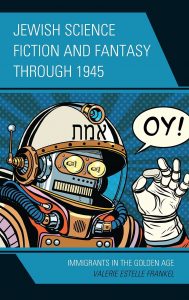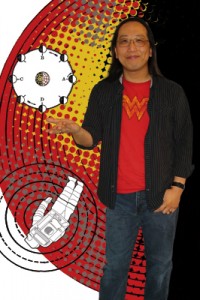The Year in Review 2021 by Alvaro Zinos-Amaro

Last year in this space I mentioned the field’s ongoing engagement with older genre history, and while there are some titles of a similar ilk in this year’s crop, there are also, it seems to me, more studies of recent fiction and contemporary trends, as well as forward-looking surveys on a diversity of aesthetic spaces. Perhaps, given the current state of world affairs, this heightened attention on futurity is less a sign of optimism and more an automatic reflex to evade the nostalgia of a seemingly irreplicable past and the tedium of a seemingly endless now. Then again, since many of these books were surely years in the making, it’s more likely a meaningless coincidence (though if I were to make one forecast, I’d say that treatises on apocalyptic and post-apocalyptic narratives will flourish). William Gibson famously said that “the future is already here–it’s just not evenly distributed,” and in our twilight pandemic world, we might say the same is true of our heavily screened, Zoom-ified present.
Early in the year we saw the publication of two craft-related books, the goldmine, or possibly gold-penned mine, Pocket Workshop: Essays on Living as a Writer, edited by Tod McCoy & M. Huw Evans, and one title I didn’t cover, Angela Slatter’s You Are Not Your Writing & Other Sage Advice. It contains exactly what the tin advertises. “We are frail, we are fragile, we are insecure,” notes Slatter, “but we have a core of steel (that’s how we survive) so we write and we keep writing.” Her career exemplifies this, and her counsel is as practicable as it is practical, all dispensed in a witty, no-nonsense way that does not require a spoonful of sugar to go down – it’s more like the medicine and sugar combined into one.
 On the academic front, Thomas Connolly’s After Human is an ambitious and dense exploration of human identity in terms of narrative archetypes through the application of pre/trans/supra/post-humanist (and postmodern) notions. How does science fiction depict the non-human? Tapping a dozen key works, Connolly suggests two key ways in which this is accomplished, one assimilative and one transformative. Brent Ryan Bellamy’s Remainders of the American Century, which posits that rather than being about the end of the world, post-apocalyptic novels instead “express cultural anxiety about the end of U.S. hegemony,” leverages the powerful concept of threefold remainders to investigate the subgenre. Half a year after reading this book, I still look for clues of these remaindering processes at work both within stories and within the publishing world at large. In Diverse Futures: Science Fiction and Authors of Color, Joy Sanchez-Taylor explores a stimulating array of works by authors of color, championing a move away from persistent Eurocentric perspectives. She argues that “displacement, diaspora, and marginalization” tend to be common, and thus unifying, concepts that make a cross-comparison of different races or ethnicities fruitful. Sanchez-Taylor’s concept of “double estrangement” strikes me as quite useful, and ready for further field testing. Additionally, as I was mentioning before, it’s a pleasure to see detailed discussions of works published during the last decade.
On the academic front, Thomas Connolly’s After Human is an ambitious and dense exploration of human identity in terms of narrative archetypes through the application of pre/trans/supra/post-humanist (and postmodern) notions. How does science fiction depict the non-human? Tapping a dozen key works, Connolly suggests two key ways in which this is accomplished, one assimilative and one transformative. Brent Ryan Bellamy’s Remainders of the American Century, which posits that rather than being about the end of the world, post-apocalyptic novels instead “express cultural anxiety about the end of U.S. hegemony,” leverages the powerful concept of threefold remainders to investigate the subgenre. Half a year after reading this book, I still look for clues of these remaindering processes at work both within stories and within the publishing world at large. In Diverse Futures: Science Fiction and Authors of Color, Joy Sanchez-Taylor explores a stimulating array of works by authors of color, championing a move away from persistent Eurocentric perspectives. She argues that “displacement, diaspora, and marginalization” tend to be common, and thus unifying, concepts that make a cross-comparison of different races or ethnicities fruitful. Sanchez-Taylor’s concept of “double estrangement” strikes me as quite useful, and ready for further field testing. Additionally, as I was mentioning before, it’s a pleasure to see detailed discussions of works published during the last decade.
I discussed the three aforementioned titles in detail throughout the year, but now let me bring to your attention four additional volumes that may prove equally tempting to the academically minded. Hua Li’s Chinese Science Fiction during the Post-Mao Cultural Thaw argues that SF of this period strove “to overcome the limitations of both kexue wenyi (literature and art about science) and children’s literature, and thereby took its rightful place in Chinese literature as an independent subgenre of popular fiction.” Li delves into the production, publication, and reception of hundreds of works by dozens of writers; this is a very welcome addition to the sub-genre of SF literary histories. Roger A. Sneed’s The Dreamer and the Dream: Afrofuturism and Black Religious Thought offers a thoughtful examination of the connections between Black theological beliefs and Black cultural productions with heavy speculative elements. Fans of Octavia Butler, Star Trek: Deep Space Nine, and Black Panther will find accessible points of entry into the discussion. Again, I appreciate a concluding chapter willing to speculate on “The Shape of Things to Come”. From Darko Suvin, the noted SF academic who has been publishing important and sometimes term-shifting theoretical work since the 1970s, we have Disputing the Deluge: Collected 21st-Century Writings on Utopia, Narration, and Survival. Editor Hugh C. O’Connell has done a fine job curating 24 engaging pieces, ranging from remembrances of writers like Stanislaw Lem and Frederik Pohl to more recent and somber reflections like “Antiutopia in Coronisation Times: Capitalocene and Death”. The essays are sequenced chronologically, but I find that this is the kind of career retrospective best consumed with a bit of randomizing whimsy. In Encountering the Sovereign Other: Indigenous Science Fiction, Miriam C. Brown Spiers again redirects our attention away from Euro-American literary traditions, in this case to Native ones. Spiers organizes the discussion of science fiction written by Indigenous authors into four chapters that variously look at renewed nuclear fears, border crossings, dystopian sovereignty, and the concept of rewriting removals, all anchored by inviting example texts.
 We move now from the academic to the panoramic. Writer and futurist David Brin, sterling stalwart and gentle gadfly, has collected in Vivid Tomorrows: On Science Fiction and Hollywood a cornucopia of opinions, provocations, and interventions. This is the closest we’re likely to get during the pandemic to an epic, 3:00 a.m., bar-side rant about movies from one of our most enduring provocateurs: read at your own perilous pleasure. Indefatigable anthologist and brilliantly meticulous genre historian Mike Ashley has produced in Yesterday’s Tomorrows: The Story of Classic British Science Fiction in 100 Books, an endlessly perusable and edifying survey, with excellently apportioned coverage of classics and obscure works alike. The 16 color center plates are also not to be missed. Another really fun non-fiction discovery for me this year was Dangerous Visions and New Worlds: Radical Science Fiction, 1950–1985, edited by Andrew Nette & Iain McIntyre, a dazzling and somewhat free-wheeling pop archival history of one of our genre’s most revolutionary and fractured periods, one that perhaps presages some of our own present-day upheavals. The book’s glossy artwork and coffee-table presentation belie the tome’s richly researched, minutiae-laden contents, sure to entertain any devotee of the New Wave. Philip Ball, veteran science popularizer, suggests in The Modern Myths: Adventures in the Machinery of the Popular Imagination that certain narratives rich in ambiguity, contradiction, and the potential for re-assembly by other hands will likely endure for decades if not centuries to come. Think you know classics like Robinson Crusoe, Frankenstein, The Strange Case of Dr. Jekyll and Mr. Hyde, or even Batman? By approaching these works from the perspective of the eponymous “modern myth,” Ball injects them with energy and brings them to life in startling new ways. Roger Luckhurst, editor of the books Late Victorian Gothic Tales and The Cambridge Companion to Dracula, now offers Gothic: An Illustrated History, which Michael Dirda has described as “a substantial overview of horror in books, art and film” by someone who “knows his subject inside out.” I was impressed by the erudition of Luckhurst’s earlier social history of science fiction and am looking forward to diving into this lavishly illustrated book on horror. Valerie Estelle Frankel, prolific editor and non-fiction writer, whose previous titles include Women in Game of Thrones: Power, Conformity and Resistance and Women in Doctor Who: Damsels, Feminists and Monsters, has published two recent titles of interest: Jewish Science Fiction and Fantasy Through 1945: Immigrants in the Golden Age and The Villain’s Journey: Descent and Return in Science Fiction and Fantasy. The former chronicles, among other things, precursors of the modern fantastic in the monsters of Jewish folklore, Jewish-Belgian Hugo Gernsback’s founding of Amazing Stories, and the creation of comic book superheroes such as Superman, Captain America, Batman, Sheena, Black Canary, and Green Lantern by Jewish artists and storytellers. Fascinating material. In the latter, Frankel takes us on a refreshing departure from the hero’s journey to follow, instead, the formation (and sometimes redemption) of villains. Lamenting that the myth of Medea and the film sequence showing the rise of Darth Vader are two of our few explicit “origin stories” of villains, Frankel proceeds to schematize her theory of the villain’s journey in direct contrast to Campbell’s framework of the hero’s journey. “This book,” Frankel observes, “is being written at a time when villain’s stories are particularly popular,” and her many diverting examples, sourced from various forms of media, prove that this is worth paying attention to. Douglas Wolk spent years reading all 27,000 Marvel comics and imagining that they form one single, still-unfolding mega-text: he reports on his findings in the entertaining, endearing, and slightly zany All of the Marvels: A Journey to the Ends of the Biggest Story Ever Told.
We move now from the academic to the panoramic. Writer and futurist David Brin, sterling stalwart and gentle gadfly, has collected in Vivid Tomorrows: On Science Fiction and Hollywood a cornucopia of opinions, provocations, and interventions. This is the closest we’re likely to get during the pandemic to an epic, 3:00 a.m., bar-side rant about movies from one of our most enduring provocateurs: read at your own perilous pleasure. Indefatigable anthologist and brilliantly meticulous genre historian Mike Ashley has produced in Yesterday’s Tomorrows: The Story of Classic British Science Fiction in 100 Books, an endlessly perusable and edifying survey, with excellently apportioned coverage of classics and obscure works alike. The 16 color center plates are also not to be missed. Another really fun non-fiction discovery for me this year was Dangerous Visions and New Worlds: Radical Science Fiction, 1950–1985, edited by Andrew Nette & Iain McIntyre, a dazzling and somewhat free-wheeling pop archival history of one of our genre’s most revolutionary and fractured periods, one that perhaps presages some of our own present-day upheavals. The book’s glossy artwork and coffee-table presentation belie the tome’s richly researched, minutiae-laden contents, sure to entertain any devotee of the New Wave. Philip Ball, veteran science popularizer, suggests in The Modern Myths: Adventures in the Machinery of the Popular Imagination that certain narratives rich in ambiguity, contradiction, and the potential for re-assembly by other hands will likely endure for decades if not centuries to come. Think you know classics like Robinson Crusoe, Frankenstein, The Strange Case of Dr. Jekyll and Mr. Hyde, or even Batman? By approaching these works from the perspective of the eponymous “modern myth,” Ball injects them with energy and brings them to life in startling new ways. Roger Luckhurst, editor of the books Late Victorian Gothic Tales and The Cambridge Companion to Dracula, now offers Gothic: An Illustrated History, which Michael Dirda has described as “a substantial overview of horror in books, art and film” by someone who “knows his subject inside out.” I was impressed by the erudition of Luckhurst’s earlier social history of science fiction and am looking forward to diving into this lavishly illustrated book on horror. Valerie Estelle Frankel, prolific editor and non-fiction writer, whose previous titles include Women in Game of Thrones: Power, Conformity and Resistance and Women in Doctor Who: Damsels, Feminists and Monsters, has published two recent titles of interest: Jewish Science Fiction and Fantasy Through 1945: Immigrants in the Golden Age and The Villain’s Journey: Descent and Return in Science Fiction and Fantasy. The former chronicles, among other things, precursors of the modern fantastic in the monsters of Jewish folklore, Jewish-Belgian Hugo Gernsback’s founding of Amazing Stories, and the creation of comic book superheroes such as Superman, Captain America, Batman, Sheena, Black Canary, and Green Lantern by Jewish artists and storytellers. Fascinating material. In the latter, Frankel takes us on a refreshing departure from the hero’s journey to follow, instead, the formation (and sometimes redemption) of villains. Lamenting that the myth of Medea and the film sequence showing the rise of Darth Vader are two of our few explicit “origin stories” of villains, Frankel proceeds to schematize her theory of the villain’s journey in direct contrast to Campbell’s framework of the hero’s journey. “This book,” Frankel observes, “is being written at a time when villain’s stories are particularly popular,” and her many diverting examples, sourced from various forms of media, prove that this is worth paying attention to. Douglas Wolk spent years reading all 27,000 Marvel comics and imagining that they form one single, still-unfolding mega-text: he reports on his findings in the entertaining, endearing, and slightly zany All of the Marvels: A Journey to the Ends of the Biggest Story Ever Told.
 As might be expected on any given year, 2021 also saw the publication of author-specific studies. F. Brett Cox’s Roger Zelazny (Modern Masters of Science Fiction) does a marvelous job of balancing concision with thoroughness in its examination of a complicated, richly allusive body of work by one of our most celebrated practitioners. Joe Sanders’s insightful and comprehensive Michael Bishop and the Persistence of Wonder: A Critical Study of the Writings makes a compelling case for why Bishop should be amply fêted for his singular literary accomplishments. Lastly, Claire Tomalin’s recent The Young H. G. Wells: Changing the World tackles well-trodden ground with vim and vigor, perhaps taking inspiration from the very man who, despite chronic, life-threatening illnesses, managed to produce, in the first act of a long-lived career, a handful of visionary and indelible masterpieces.
As might be expected on any given year, 2021 also saw the publication of author-specific studies. F. Brett Cox’s Roger Zelazny (Modern Masters of Science Fiction) does a marvelous job of balancing concision with thoroughness in its examination of a complicated, richly allusive body of work by one of our most celebrated practitioners. Joe Sanders’s insightful and comprehensive Michael Bishop and the Persistence of Wonder: A Critical Study of the Writings makes a compelling case for why Bishop should be amply fêted for his singular literary accomplishments. Lastly, Claire Tomalin’s recent The Young H. G. Wells: Changing the World tackles well-trodden ground with vim and vigor, perhaps taking inspiration from the very man who, despite chronic, life-threatening illnesses, managed to produce, in the first act of a long-lived career, a handful of visionary and indelible masterpieces.
I’ll end with a Samuel R. Delany bonus round. Edited by Bill Wood, and featuring contributions by Douglas Barbour, Mary Kay Bray, Rudi Dornemann, Harlan Ellison, Robert Elliot Fox, Jean Marc Gawron, Kenneth R. James, Gerald Jonas, John Nizalowski, Steven Paley, Darrell Schweitzer, Steven Shaviro, K. Leslie Steiner, Theodore Sturgeon, and Delany himself, is the non-fiction anthology On Samuel R. Delany’s Dhalgren. Over the last decade or so we’ve seen a number of exegetical analyses, most notably by Michael Andre-Driussi, of Gene Wolfe’s body of work, and I welcome similar endeavors for Delany, specially his SFnal magnum opus. In addition, three new non-fiction collections of Delany material, Of Solids and Surds: Notes for Noël Sturgeon, Marilyn Hacker, Josh Lukin, Mia Wolff, Bill Stribling, and Bob White, along with Occasional Views, Volume 1: “More About Writing” and Other Essays and Occasional Views, Volume 2: “The Gamble” and Other Essays, find the writer in top-notch form. The first is part of the “Why I Write” book series, and Delany arrives at many answers to the titular question by means of engrossing anecdotes and personal reminiscences, though sometimes his responses are simply pithy affirmations (e.g. “I wrote because it was fun”). The two essay collections contain, respectively, 32 and 26 wide-ranging pieces, the latter including lectures and interviews. These three books together form a rich portrait of Delany’s inestimable contributions to commentary and craft over the last fifty years, and in the best manner of such things, whet the appetite for more. In a piece called “Student of Desire,” Delany writes that David Wojnarowicz was a “sexual radical.” Continues Delany: “What does that mean? He tried to write about sex honestly. He tried to picture it accurately.” And so it may be said of Delany himself regarding art and writing. How heartening to see one of our greatest living writers continue to be as radical as ever.
Alvaro Zinos-Amaro, Roundtable Editor, is co-author of a book of interviews with Robert Silverberg, Traveler of Worlds, that was a Hugo and Locus Award finalist in 2017. Alvaro’s more than 30 stories and 100 reviews, essays and interviews have appeared in magazines like Clarkesworld, Asimov’s, Apex, Analog, Lightspeed, Nature, Strange Horizons, Beneath Ceaseless Skies, Galaxy’s Edge, Lackington’s, and anthologies such as The Year’s Best Science Fiction & Fantasy 2016, Cyber World, Humanity 2.0, and This Way to the End Times.
This review and more like it in the February 2022 issue of Locus.
 While you are here, please take a moment to support Locus with a one-time or recurring donation. We rely on reader donations to keep the magazine and site going, and would like to keep the site paywall free, but WE NEED YOUR FINANCIAL SUPPORT to continue quality coverage of the science fiction and fantasy field.
While you are here, please take a moment to support Locus with a one-time or recurring donation. We rely on reader donations to keep the magazine and site going, and would like to keep the site paywall free, but WE NEED YOUR FINANCIAL SUPPORT to continue quality coverage of the science fiction and fantasy field.
©Locus Magazine. Copyrighted material may not be republished without permission of LSFF.







